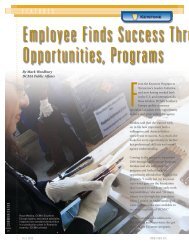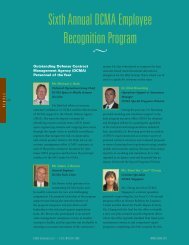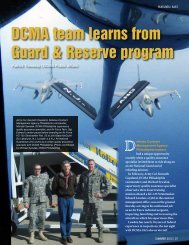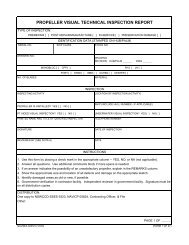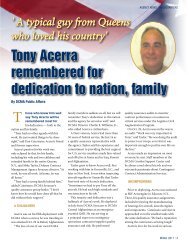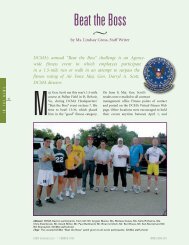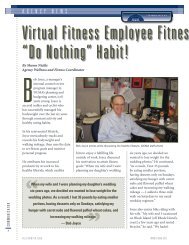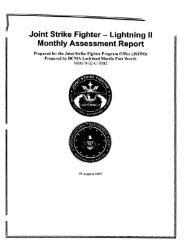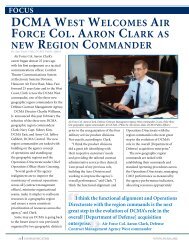Cohort V: a leadership Model for all of dCMa
Cohort V: a leadership Model for all of dCMa
Cohort V: a leadership Model for all of dCMa
You also want an ePaper? Increase the reach of your titles
YUMPU automatically turns print PDFs into web optimized ePapers that Google loves.
l e a d e r s h i p<br />
18<br />
<strong>Cohort</strong> V: a <strong>leadership</strong> <strong>Model</strong> <strong>for</strong> <strong>all</strong> <strong>of</strong> <strong>dCMa</strong><br />
by DCMA Leadership Class — <strong>Cohort</strong> V (submitted by Mr. Stuart Harrow,<br />
Chief, Burlington Team, DCMA Philadelphia)<br />
Lead: to show the way to, or direct the course <strong>of</strong>,<br />
by going be<strong>for</strong>e or along with; conduct; guide; to mark the way <strong>for</strong><br />
— Webster’s New World College Dictionary, 4th ed.<br />
Thursday morning, Dec. 9, 2004, a new<br />
training day began in Atlanta, Ga., <strong>for</strong> the<br />
29 Defense Contract Management Agency<br />
(DCMA) supervisors and managers <strong>of</strong><br />
<strong>Cohort</strong> V (a cohort is a united group <strong>of</strong><br />
people sharing a common factor). Group<br />
members soon found that although they had<br />
much in common — they were among 900<br />
supervisors and managers in DCMA<br />
— they were a very diverse group.<br />
Some approached the training<br />
eagerly — others were apprehensive;<br />
some grabbed the chance to attend<br />
— many did not want to be there<br />
and had come only at their bosses’<br />
requests; some were handpicked<br />
— others were a second choice.<br />
The members also had a range<br />
<strong>of</strong> backgrounds: from first-time,<br />
newly-promoted supervisors to<br />
those with over 30 years in supervision; from<br />
supervisors assigned to a team <strong>of</strong> five specialists<br />
to second-level mangers supervising an <strong>of</strong>fice<br />
Ms. Pat Roderick<br />
and Ms. Leslie<br />
Gregg have<br />
achieved DCMA’s<br />
vision <strong>of</strong> making<br />
the Agency a<br />
preferred employer.<br />
<strong>of</strong> over 100 people; from DCMA members<br />
who began their civil service careers at DCMA<br />
and its predecessors to those recently joining<br />
DCMA after a military career.<br />
Ms. Pat Roderick, human resources specialist<br />
from DCMA West in Carson City, Calif., said<br />
that in fiscal year 2004, each District was tasked<br />
with developing <strong>leadership</strong> training<br />
<strong>for</strong> its supervisors, managers and<br />
executives, and each District <strong>of</strong>fered<br />
its own respective <strong>leadership</strong> training.<br />
Late in this fiscal year, DCMA<br />
decided to adopt the DCMA District<br />
West <strong>leadership</strong> training model <strong>for</strong><br />
<strong>all</strong> DCMA Districts in a conscious<br />
ef<strong>for</strong>t to give DCMA supervisors the<br />
skills needed to help make DCMA<br />
“the employer <strong>of</strong> choice.” Despite<br />
budget cuts and shortf<strong>all</strong>s, this<br />
training has retained its funding and priority.<br />
Ms. Roderick has spent the last 20 years <strong>of</strong>fering<br />
<strong>leadership</strong> training to DCMA . Her expertise and<br />
(Above left) Class participants summarize what they’ve learned by dramatizing a learning objective. (Photo by Mr. Scott Scruggs.)<br />
(In the middle) <strong>Cohort</strong> V participants Ms. Lena Unverrich, Mr. Mark Rushfeldt and Mr. Gary Curry spend an evening together<br />
outside class. (Photo by Mr. Scott Scruggs.) (Above right) Instructor Mr. Barry Burgland, Center <strong>for</strong> Creative Leadership, shares a<br />
light moment with <strong>Cohort</strong> V members Mr. Ed Graves, Mr. Robert Chen, Ms. Mary Pleticha, Mr. Ed Hendela, Ms. Brigitte Bryant and<br />
Ms. Janet Lopez. (Photo by Mr. Scott Scruggs.)<br />
d C M a C o m m u n i c a t o r | s p r i N G 2 0 0 5 W W W . d C M a . M i l
C o h o r T V : a l e a d e r s h i p M o d e l f o r a l l o f d C M a<br />
(Left) Many exercises draw on communication skills and problem solving. (Photo by Mr. Robert Chen, DCMA District West<br />
Headquarters.) (Right) This exercise, “put a straw through a potato,” demonstrated that what we thought was “impossible”<br />
turned out to be merely difficult. (Photo by Mr. Robert Chen, DCMA District West Headquarters.)<br />
her work with a dedicated sponsor and leader,<br />
Ms. Leslie Gregg, <strong>for</strong>mer DCMA District West<br />
deputy director, have achieved DCMA’s vision <strong>of</strong><br />
making the Agency a preferred employer.<br />
Following Ms. Roderick, the instructors<br />
announced their strictly en<strong>for</strong>ced “no cell<br />
phone, pager and/or BlackBerry®” policy 1<br />
during actual classroom learning and then gave<br />
a broad overview <strong>of</strong> the four parts <strong>of</strong><br />
the curriculum:<br />
• The Leadership Ch<strong>all</strong>enge —<br />
Leading Through Change. This<br />
session examined how people deal<br />
with change and included skills <strong>for</strong><br />
initiating and sustaining change.<br />
• Emotional Intelligence as a Leadership<br />
Skill/360-Degree Assessment. This<br />
session provided mechanisms <strong>for</strong><br />
successfully achieving a balance between<br />
our personal and pr<strong>of</strong>essional lives, thus<br />
enabling employees to per<strong>for</strong>m to their<br />
maximum potential.<br />
• Coaching Skills <strong>for</strong> Federal Executives. This<br />
course covered the difference between coaching<br />
and counseling and how to use coaching to help<br />
employees realize their potential, focus on their<br />
special skills and help others by example.<br />
• Building a Great Place <strong>for</strong> People to Work and<br />
Leaders Growing Leaders. This training clarified<br />
the difference between viewing a job as “just a<br />
job/paycheck” and thinking, “I can’t wait to get<br />
to work today to see what ch<strong>all</strong>enges are there<br />
<strong>for</strong> me to tackle!” The course also provided<br />
methods <strong>for</strong> identifying people who are willing<br />
to accept both the in<strong>for</strong>mal and <strong>for</strong>mal roles <strong>of</strong><br />
DCMA leaders, because <strong>leadership</strong> doesn’t<br />
always have a <strong>for</strong>mal title.<br />
The classes were designed to provide the tools<br />
needed to lead people to excellence. A quote<br />
in The Leadership Ch<strong>all</strong>enge by Mr. Jim Kouzes<br />
shows how this ultimately translates into great<br />
customer service: “This business is re<strong>all</strong>y about<br />
people. Our ability to deliver amazing<br />
customer service is <strong>all</strong> about people<br />
and making them feel motivated,<br />
empowered and trusted. They need<br />
to feel that they know what is at stake<br />
and how they make a difference.<br />
If we are not re<strong>all</strong>y committed<br />
to our own people, how can we<br />
expect them to be committed to<br />
our customers?” The class also<br />
used ideas from Primal Leadership<br />
by Mr. Daniel Goleman to bring<br />
this focus on customers into sharp relief.<br />
One <strong>Cohort</strong> V member summed up the group’s<br />
experience in a rap, which he presented:<br />
While doin’ time at DCMA,<br />
Heard primal <strong>leadership</strong> was the way.<br />
Being self-aware, having empathy,<br />
Improves relations, brings harmony.<br />
Moving through this chapter <strong>of</strong> <strong>Cohort</strong> V,<br />
Know we learned a lot — that ain’t no jive.<br />
When you go home, good luck to <strong>all</strong>,<br />
Learned a little something and had a b<strong>all</strong>!<br />
Cha-ca-cha, cha-ca cha, cha-ca-cha-ca-cha …<br />
(In the middle) One <strong>Cohort</strong> member <strong>of</strong>fered tips <strong>for</strong> retaining a positive outlook in “An Anti-Depression Kit.” Each member<br />
contributed freely from his or her life and work experiences. (Photo by Mr. Robert Chen, DCMA District West Headquarters.)<br />
W W W . d C M a . M i l d C M a C o m m u n i c a t o r | s p r i N G 2 0 0 5<br />
1 BlackBerry ® is a<br />
registered trademark<br />
<strong>of</strong> the Research In<br />
Motion company.<br />
19<br />
l e a d e r s h i p
l e a d e r s h i p<br />
20<br />
During the first set <strong>of</strong> classes, the diverse<br />
collection <strong>of</strong> 29 individuals slowly <strong>for</strong>med a<br />
unified group. Initi<strong>all</strong>y, few anticipated the<br />
kind <strong>of</strong> benefits they would receive, but by<br />
the end <strong>of</strong> the course every single person<br />
came away with a sense <strong>of</strong> self-awareness and<br />
determination to make things better both<br />
person<strong>all</strong>y and pr<strong>of</strong>ession<strong>all</strong>y. Part <strong>of</strong> the<br />
program is “instrumentation,” where <strong>leadership</strong><br />
styles, people skills, peer perceptions, decisionmaking<br />
preferences and emotional intelligence<br />
were measured.<br />
The best<br />
way to effect<br />
organizational<br />
culture change<br />
is through a<br />
focused training<br />
program, one<br />
cohort at a time.<br />
C o h o r T V : a l e a d e r s h i p M o d e l f o r a l l o f d C M a<br />
After the first two classes, <strong>all</strong> <strong>Cohort</strong> V members are eagerly awaiting the<br />
remainder <strong>of</strong> the course. They feel that … the possibilities <strong>for</strong> positive<br />
outcomes could be endless.<br />
As the training progressed,<br />
assessment instruments were<br />
given but many were confused<br />
about their purpose. And then<br />
there was light. The program was<br />
building toward the day when<br />
each member would receive<br />
feedback: very personal, focused,<br />
relevant and sensitive. Each had<br />
the opportunity to meet with a<br />
pr<strong>of</strong>essional “feedback giver” who<br />
knew more about the members<br />
than they thought possible, and<br />
their insights provided growth.<br />
After the first two classes, <strong>all</strong> <strong>Cohort</strong> V members<br />
are eagerly awaiting the remainder <strong>of</strong> the<br />
course. They feel that if they could change so<br />
significantly after only seven days, then after<br />
graduating from the training, the possibilities<br />
<strong>for</strong> positive outcomes could be endless.<br />
The participants rated the training as very<br />
effective. Following are some <strong>of</strong> the enthusiastic<br />
comments from the participants regarding<br />
their experiences:<br />
• “Intimidating. Enlightening.”<br />
• “[I feel] <strong>for</strong>tunate that early in my career I got<br />
to take a class like this. It makes me realize the<br />
ch<strong>all</strong>enge I face.”<br />
• “Advertised by three folks from my <strong>of</strong>fice as the<br />
best class they’ve had in 32 years.”<br />
• “I’m starting to see a glimmer, that spark<br />
<strong>of</strong> hope that I had when I first started with<br />
the Agency.”<br />
Through the training, members learned about<br />
themselves and became better leaders as a result.<br />
They now see more clearly that the best way to<br />
effect organizational culture change is through a<br />
focused training program, one cohort at a time.<br />
At this time over 120 DCMA leaders have been<br />
through this training. They have more to learn,<br />
more to share and more to <strong>of</strong>fer DCMA and<br />
its employees, and they are working together to<br />
help make DCMA the employer <strong>of</strong> choice.<br />
<strong>Cohort</strong> Program<br />
<strong>for</strong>: Supervisors, Managers & Team Leaders<br />
Initiated by District West, the <strong>Cohort</strong> Program has been adopted <strong>for</strong> use Agency-wide.<br />
The program involves a series <strong>of</strong> five courses, delivered over a three- to four-month<br />
period. To build networking and camaraderie and foster a sense <strong>of</strong> community, attendees<br />
take <strong>all</strong> classes as a group. This program also serves to commingle the District East and<br />
District West work<strong>for</strong>ces and bridge some <strong>of</strong> the gaps between the two. The goal is to<br />
initiate three to four more cohorts this fiscal year (<strong>Cohort</strong> VI began in February).<br />
(Opposite) Navy Electrician’s Mate 3rd Class Christina Henke documents tag numbers <strong>of</strong> personal electrical devices aboard USS<br />
Kitty Hawk. As a component <strong>of</strong> the Kitty Hawk’s electrical safety program, <strong>all</strong> personal electrical devices plugged into the ship’s<br />
electrical system must be checked <strong>for</strong> safety and identified to be within standards. (U.S. Navy photo by Photographer’s Mate<br />
Airman Joseph R. Schmitt.)<br />
d C M a C o m m u n i c a t o r | s p r i N G 2 0 0 5 W W W . d C M a . M i l



